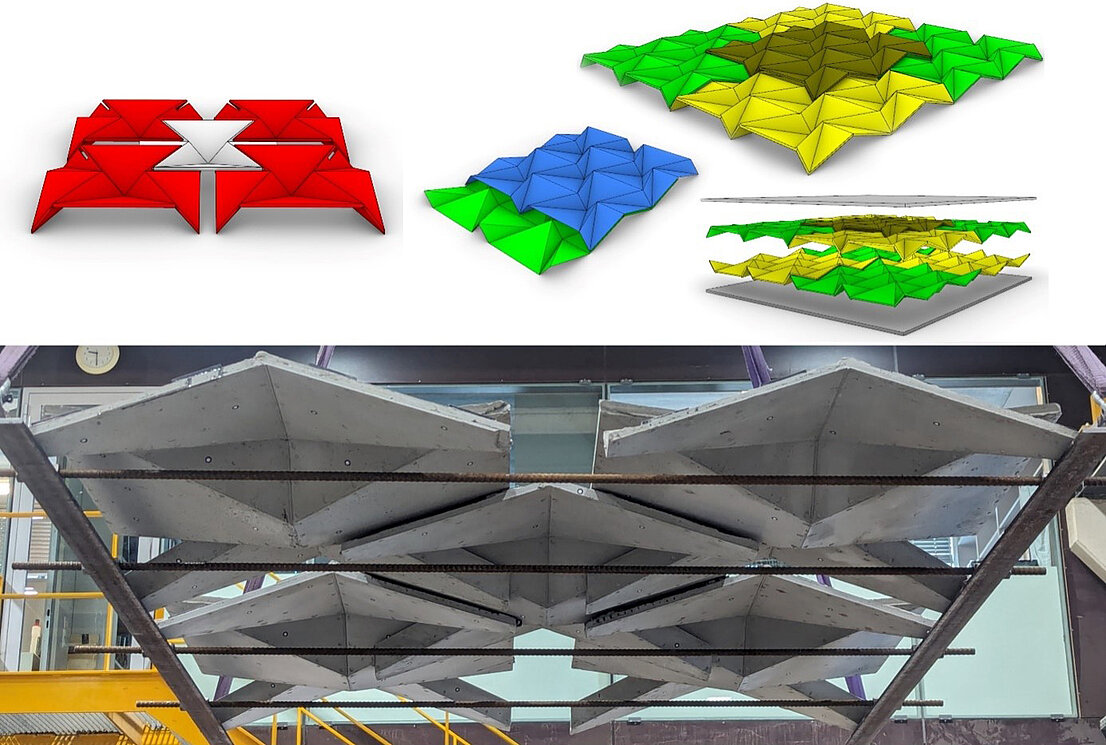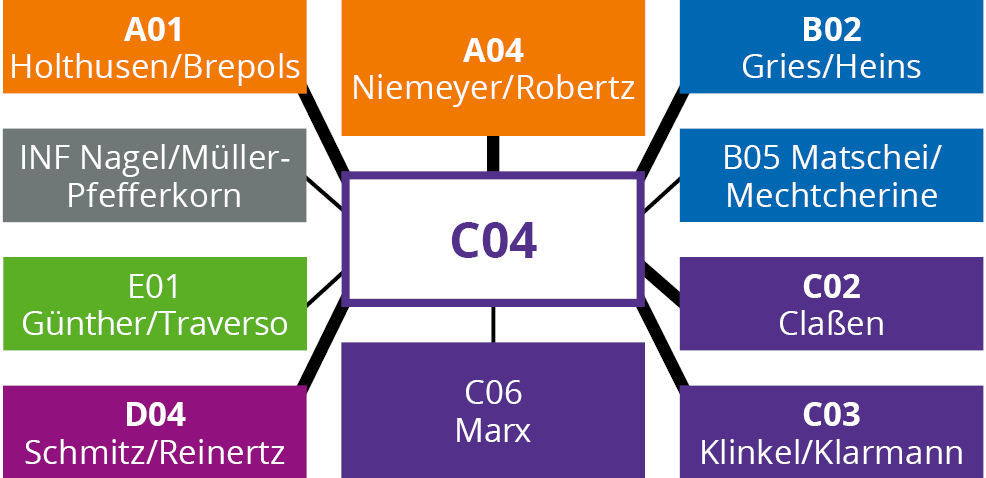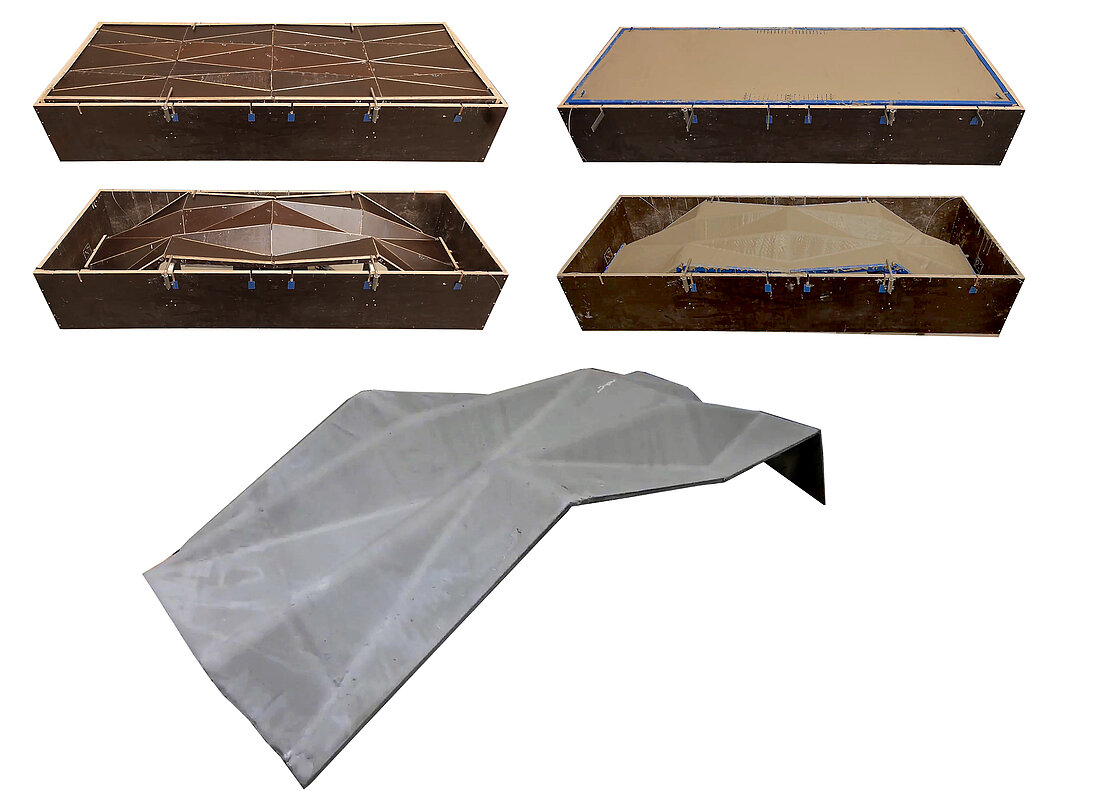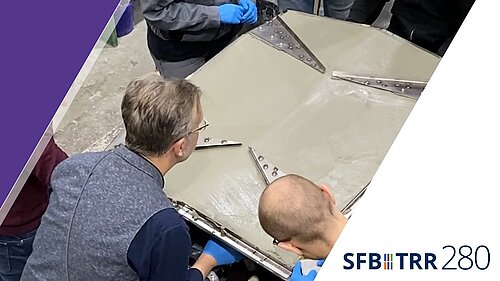Modular systems of semi-finished folded components | Funding Period 2
In project C04, a novel construction approach for thin-walled carbon-reinforced concrete (CRC) elements made of modular folded components is developed. By leveraging origami principles and the foldability of the textile reinforcement, the project aims to create adaptable, high-performance, and resource-efficient CRC elements. To achieve this, a design principle based on waterbomb origami patterns, and a novel fold, plug, and lock concept is developed enabling flexible and resource-efficient production. Analytical and numerical models for module folding kinematics, fabrication, assembly, and structural performance will be developed and validated, with material-efficiency integrated into design and performance assessment. This will allow bridging the gap between material utilization, geometrical design and fabrication processes of CRC components.

Scientists
![Prof. Dr. habil. Rostislav Chudoba [Translate to English:]](/fileadmin/_processed_/e/4/csm_C04_Chudoba_quadratisch_alvarez_034903dea2.jpg)
D-52074 Aachen (Germany)

52074 Aachen (Germany)
Cooperations

Ehemalige | Former involved
Kai Gebuhr (doctoral researcher, TU Dresden, 10/2020 – 10/2021)
Josiane Giese (doctoral researcher, TU Dresden, 10/2021 – 06/2024)
Dr.-Ing. Frank Schladitz (project manager, 07/2020 – 06/2024)
Homam Spartali (doctoral researcher, RWTH Aachen, 07/2020 – 06/2024)
Stability and Quasi-Ductility of Carbon Reinforced Concrete Structural Members | Funding Period 1
The central question in this project is how to achieve structural behavior with high stiffness in the service condition and, at the same time, a sufficiently large deformation capacity prior to failure using carbon-reinforced concrete, a composite consisting of solely brittle material components.
Due to the brittle behavior of carbon reinforcement, other sources of the stress redistribution need to be exploited in order to achieve the required ductility. During the loading, carbon-reinforced concrete exhibits local deterioration mechanisms such as debonding and the development of finely distributed cracks along the length of an element. The stress redistribution mechanisms occur especially in tensile zones and are accompanied with stiffness reduction. Methods exploting these mechanisms in the design of spatial thin-walled structures with ductile structural behavior are investigated in Aachen. The long term goal of the numerical and experimental research is to exploit the synergetic potential between form and material behaviour available in folded carbon-reinforced concrete shells.
At TU Dresden, the focus is on stability phenomena during normal force loading of filigree carbon-reinforced concrete components.


Publikationen | Publications
Chudoba, R.; Li, Y.; Rypl, R.; Spartali, H.; Vořechovský, M. (2021) Probabilistic multiple cracking model of brittle-matrix composite based on a one-by-one crack tracing algorithm in: Applied Mathematical Modelling 92, issue April, p. 315–332 – DOI: 10.1016/j.apm.2020.10.041
Chudoba, R.; Niemeyer, A. C.; Spartali, H.; Robertz, D.; Plesken, W. (2021) Description of the origami waterbomb cell kinematics as a basis for the design of thin-walled oricrete shells in: Behnejad, A.; Parke, G.; Samavati, O. [eds.] Inspiring the Next Generation – Proceedings of IASS 2020/21, 23.–27.08.2021 in Guildford (UK), p. 2681–2689 – DOI: 10.5281/zenodo.6759486
Chudoba, R.; Spartali, H.; Adam, V.; Beckmann, B. (2024) Performance-based Analysis of Embodied Carbon Footprint of Rectangular CFRP-Reinforced Concrete Beams in: Mechtcherine, V.; Signorini, C.; Junger, D. [eds.]: Transforming Construction: Advances in Fiber Reinforced Concrete – Proc. of XI RILEM-fib Int. Symp. on Fiber Reinforced Concrete (BEFIB 2024), 15.–18.09.2024 in Dresden, publ. in RILEM Bookseries, Vol. 54, Cham: Springer Nature Switzerland, p. 670–677 – https://doi.org/10.1007/978-3-031-70145-0_80
Giese, J.; Beckmann, B.; Schladitz, F.; Marx, S.; Curbach, M. (2023) Effect of Load Eccentricity on CRC Structures with Different Slenderness Ratios Subjected to Axial Compression in: Buildings 13, issue 10, 2489 – DOI: 10.3390/buildings13102489
Giese, J.; Curbach, M.; Chudoba, R.; Adam, V.; Beckmann, B. (2024) Thin carbon-reinforced concrete components under combined compressive and bending load in: Mechtcherine, V.; Signorini, C.; Junger, D. [eds.]: Transforming Construction: Advances in Fiber Reinforced Concrete – Proc. of XI RILEM-fib Int. Symp. on Fiber Reinforced Concrete (BEFIB 2024), 15.–18.09.2024 in Dresden, publ. in RILEM Bookseries, Vol. 54, Cham: Springer Nature Switzerland, p. 696–704 – DOI: 10.1007/978-3-031-70145-0_83
Giese, J.; Herbers, M.; Liebold, F.; Wagner, F.; Grzesiak, S.; de Sousa, C.; Pahn, M.; Maas, H.-G.; Marx, S.; Curbach, M.; Beckmann, B. (2023) Investigation of the Crack Behavior of CRC Using 4D Computed Tomography, Photogrammetry, and Fiber Optic Sensing in Buildings 13, issue 10, 2595 – DOI: https://doi.org/10.3390/buildings13102595
Giese, J.; Spartali, H.; Beckmann, B.; Schladitz, F.; Chudoba, R. (2023) Experimental Investigation on the Buckling Behavior of Slender TRC Structures in: Ilki, A.; Çavunt, D.; Çavunt, Y. S. [eds.] Building for the Future: Durable, Sustainable, Resilient – Proc. of fib Symposium 2023, 05.–07.06.2023 in Istanbul (Turkey), publ. in: Lecture Notes in Civil Engineering 350, Cham: Springer, p. 1398–1407 – DOI: 10.1007/978-3-031-32511-3_143
Kikis, G.; Mester, L.; Chudoba, R.; Klinkel, S. (2023) Application of a microplane damage model for concrete to an isogeometric scaled boundary formulation for 3D solids in: Proc. Appl. Math. Mech. 23, issue1 – Special Issue: 92nd Annual Meeting of the International Association of Applied Mathematics and Mechanics (GAMM), e202200246 – DOI: 10.1002/pamm.202200246
Kikis, G.; Mester, L.; Spartali, H.; Chudoba, R.; Klinkel, S. (2023) Analyse des Trag- und Bruchverhaltens von Carbonbetonstrukturen im Rahmen des SFB/TRR 280 in: Bauingenieur 98, issue 07–08, p. 218–226 – DOI: 10.37544/0005-6650-2023-07-08-40
Klarmann, S.; Kikis, G.; Klinkel, S.; Chudoba, R. (2023) Isogeometric cohesive zone modeling of interfaces in reinforced concrete structures in: Proc. Appl. Math. Mech. – DOI: 10.1002/pamm.202300160
Liebold, F.; Wagner, F.; Giese, J.; Grzesiak, S.; de Sousa, C.; Beckmann, B.; Pahn, M.; Marx, S.; Curbach, M.; Maas, H.-G. (2023) Damage Analysis and Quality Control of Carbon-Reinforced Concrete Beams Based on In Situ Computed Tomography Tests in Buildings 13, issue 10, 2669 – DOI: https://doi.org/10.3390/buildings13102669
Robertz, D.; Spartali, H.; Chudoba, R.; Plesken, W.; Niemeyer, A. C. (2022) Semi-symmetric origami waterbomb cell kinematics and tessellation for the design of thin-walled folded shells in: Su-duo Xue, S.-d.; Wu, J.-z.; Sun, G.-j. [eds.] Innovation, Sustainability and Legacy – Proceedings of IASS/APCS 2022, 19.–22.09.2022 in Beijing (China), p. 2314–2324.
Spartali, H.; Hegger, J.; Beckmann, B.; Chudoba, R. (2024) Closed-form design concept for fully utilized FRP-reinforced rectangular concrete cross-sections accompanied by experimental validation on carbon-reinforced beams in Structures 61, 106042 – DOI: https://doi.org/10.1016/j.istruc.2024.106042.
Spartali, H.; Hegger, J.; Chudoba, R. (2022) Flexural behavior of CFRP reinforced beams: a case study with comparisons to steel reinforced elements in: Stokkeland, S.; Braarud, H. C. [eds.] Concrete Innovation for Sustainability – Proc. for the 6th fib International Congress 2022, 12.–16.06.2022 in Oslo (Norway), Oslo: Novus Press, p. 1470–1479 – DOI: 10.5281/zenodo.6759404
Spartali, H.; Hegger, J.; Chudoba, R. (2023) Phenomenological comparison between the flexural performance of steel- and CFRP-reinforced concrete elements in Engineering Structures 294, 116755 – DOI: https://doi.org/10.1016/j.engstruct.2023.116755.
Spartali, H.; Hegger, J.; Chudoba, R. (2023) Structural behaviour of origami-based folded shells made of carbon textile reinforced concrete in: Claßen, M.; Hegger, J.; Matschei, T.; Raupach, M. [eds.] Beiträge zur 10. DAfStb-Jahrestagung mit 62. Forschungskolloquium, 26./27.09.2023 in Aachen, p. 172–180 – DOI: 10.18154/RWTH-2023-06682
Spartali, H.; Rastegarian. S.; Will, N.; Chudoba, R. (2021) Moment-curvature model for flexural assessment of textile-reinforced concrete beams in: Si Larbi, A.; Nassif, H. [eds.] Proc. of 13th International Symposium on Ferrocement and Thin Fiber Reinforced Inorganic Matrices FERRO-13, 21.–23.06.2021 in Lyon (France, online), p. 145–156 – DOI: 10.5281/zenodo.5028860
Spartali, H.; van der Woerd, J. D.; Hegger, J.; Chudoba, R. (2022) Stress redistribution capacity of textile-reinforced concrete shells folded utilizing parameterized waterbomb patterns in: Su-duo Xue, S.-d.; Wu, J.-z.; Sun, G.-j. [eds.] Innovation, Sustainability and Legacy – Proceedings of IASS/APCS 2022, 19.–22.09.2022 in Beijing (China), p. 96–106.
Stüttgen, S.; Akpanya, R.; Beckmann, B.; Chudoba, R.; Robertz, D.; Niemeyer, A. C. (2023) Modular Construction of Topological Interlocking Blocks—An Algebraic Approach for Resource-Efficient Carbon-Reinforced Concrete Structures in Buildings 13, issue 10, 2565 – DOI: https://doi.org/10.3390/buildings13102565
Vořechovský, M.; Li, Y.; Rypl, R.; Chudoba, R. (2021) Tensile behavior of carbon textile concrete composite captured using a probabilistic multiscale multiple cracking model in: Composite Structures 277, 114624 – DOI: 10.1016/j.compstruct.2021.114624
Dissertation | Doctoral thesis
Homam Spartali: Towards an efficient design of carbon reinforced concrete elements: from prismatic beams to origami-based folded shells [Doktorarbeit | doctoral thesis]. RWTH Aachen, Datum der mündlichen Prüfung | Date of oral examination: 01.02.2024, publiziert | published: 2024, https://publications.rwth-aachen.de/record/980041/files/980041.pdf, DOI: 10.18154/RWTH-2024-02048
Studentische Arbeiten | Student's works
Gasser, R. (2020) Stand des Wissens zur Stabilität von Betonbauteilen und Ableitung von Erkenntnissen für die Carbonbetonbauweise [Diplomarbeit | Diplopma thesis] TUD
Schipka, P. (2020) Stabilität von Carbonbetonbauteilen [Diplomarbeit | Diplopma thesis] TUD
Jin, L. (2021) Einfluss von Temperaturunterschieden auf die Stabilität von Carbonbetonbauteilen [Projektarbeit | project work] TUD
Ullmann, S. (2021) Einfluss struktureller Imperfektionen auf die Stabilität von Carbonbetonbauteilen [Projektarbeit | project work] TUD
Barakat, A. (2022) Einfluss struktureller und geometrischer Imperfektionen auf die Stabilität von Carbonbeton [Projektarbeit | project work] TUD
Geerts, J. H. (2022) Experimentelle und theoretische Untersuchungen zum Biegeverhalten von Carbonbetonbauteilen [Bachelorarbeit | Bachelor's thesis] RWTH




